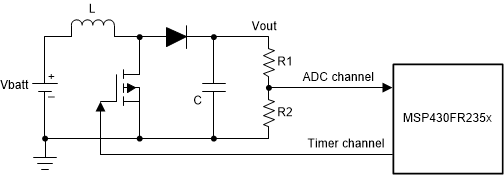SLAA897 June 2019 MSP430FR2353 , MSP430FR2355
2.3 Power Management
Handheld small pulse oximeters are typically powered using two AAA batteries. The discharge in battery voltage (can go till 1.8 V) may lead to improper functioning of the MCU and the transmit chain may shut down. Hence, to ensure proper functionality, designers need to regulate the battery voltage and boost it up to 3.3 V to maintain sufficient margin. (Typical MCU working voltage range is 1.8 V to 3.6 V).
The battery voltage can be increased by either using a dedicated boost converter device (Figure 5) or using discrete boost converter (Figure 6).
- TPS613221A is a synchronous boost converter with only 6.5-μA quiescent current.
- A discrete boost converter can be implemented by controlling the gate switching through a PWM signal generated from the timer of the MCU and sensing the output voltage by the ADC and varying the duty cycle of the PWM accordingly.
 Figure 5. Using TPS613221A to Boost the Battery Voltage
Figure 5. Using TPS613221A to Boost the Battery Voltage  Figure 6. Discrete Boost Converter Implementation
Figure 6. Discrete Boost Converter Implementation